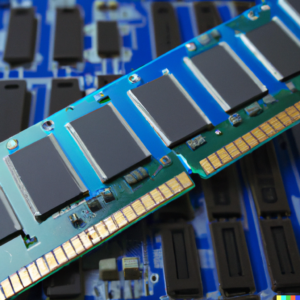 Computer RAM (Random Access Memory) is a type of computer memory that can be accessed randomly, meaning any byte of memory can be accessed without touching the preceding bytes. RAM is volatile memory, meaning it is wiped clean when the computer is turned off or rebooted. When a computer is running, it stores data that it is currently using or processing in RAM so that it can be quickly accessed by the CPU. This allows the computer to quickly retrieve and process the data, which improves overall performance.
Computer RAM (Random Access Memory) is a type of computer memory that can be accessed randomly, meaning any byte of memory can be accessed without touching the preceding bytes. RAM is volatile memory, meaning it is wiped clean when the computer is turned off or rebooted. When a computer is running, it stores data that it is currently using or processing in RAM so that it can be quickly accessed by the CPU. This allows the computer to quickly retrieve and process the data, which improves overall performance.
Types of RAM
There are several types of RAM that are commonly used in computers:
- DRAM (Dynamic Random Access Memory) is the most common type of RAM and is used in the majority of personal computers. DRAM stores each bit of data in a separate capacitor within an integrated circuit.
- SRAM (Static Random Access Memory) is faster and more expensive than DRAM. It is used in cache memory and high-performance CPUs.
- SDRAM (Synchronous Dynamic Random Access Memory) is a type of DRAM that is synchronized with the CPU’s clock, allowing for faster data access.
- DDR SDRAM (Double Data Rate Synchronous Dynamic Random Access Memory) is a faster version of SDRAM that doubles the data transfer rate by sending data on both the rising and falling edges of the clock signal.
- DDR2 SDRAM (Double Data Rate 2 Synchronous Dynamic Random Access Memory), DDR3 SDRAM (Double Data Rate 3 Synchronous Dynamic Random Access Memory), DDR4 SDRAM and DDR5 SDRAM are faster versions of SDRAM that have improved performance by increasing the clock speed and reducing the voltage required to operate.
- RDRAM (Rambus Dynamic Random Access Memory) is a type of RAM that uses a Rambus channel to increase the speed of data transfer between the memory and the CPU.
- LPDRAM (Low Power Double Data Rate Random Access Memory) is a type of RAM that is designed to reduce power consumption, it is often used in mobile devices and laptops.
- GDDR (Graphics Double Data Rate) is a type of RAM that is specifically designed for use with graphics processing units (GPUs) in video cards.
- HBM (High-Bandwidth Memory) is a new type of memory technology that is designed to be faster and have a higher memory density than GDDR, it’s mostly used in high-performance computing applications and graphics-intensive workloads.
RAM speeds
The speed of RAM is measured in MHz (Megahertz) or GHz (Gigahertz). The higher the MHz or GHz, the faster the RAM can transfer data. Common speeds for RAM include:
- DDR3: 800 MHz to 1600 MHz
- DDR4: 2133 MHz to 3200 MHz
- DDR5: 4800 MHz to 6400 MHz
The speed of the RAM is also dependent on the motherboard and processor that the RAM is being used with. The motherboard and processor must support the speed of the RAM in order for it to run at that speed. If the motherboard and processor do not support the speed of the RAM, it will run at a slower speed.
Additionally, some motherboards and processors can overclock RAM which means that they can run RAM above its rated speed, for example, running DDR4-3200 RAM on a motherboard that supports DDR4-3200 with a processor that supports DDR4-3200 and overclocking settings.
Having faster RAM will not always result in a noticeable performance increase unless your system is already memory-bound. The overall performance of a system is determined by the balance between the CPU, GPU, storage, and memory.